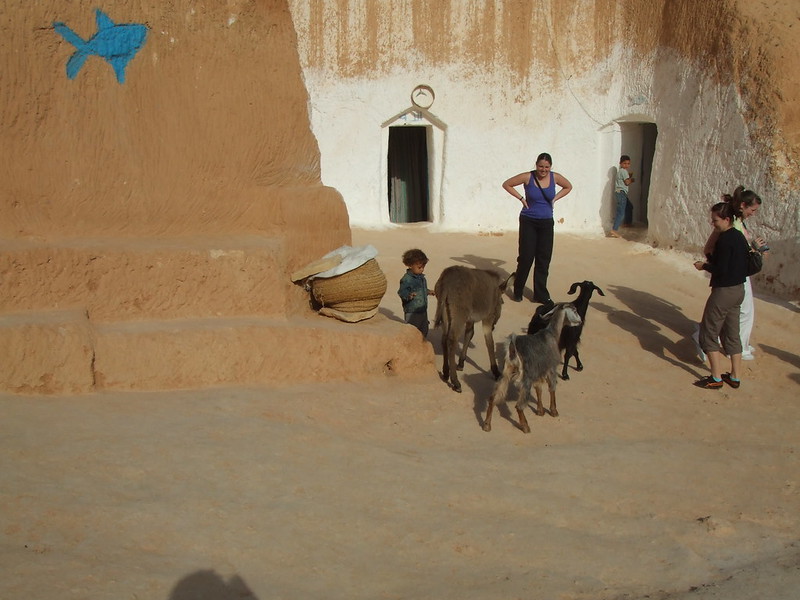 Historic troglodyte homes, located in North Africa, Libya and Tunisia are important to the cultural identity and heritage of the Amazigh community. The city of Matmata, Tunisia, once a thriving hub for tourists, now faces an uncertain future due to political instability and economic challenges. Similarly, Libya is also known for its underground homes and Roman ruins. However, questions are being raised about the viability of tourism as a source of community income amid ongoing economic and political turmoil. These challenges underscore the precarious situation of preserving and leveraging cultural sites for economic benefit in both countries.
Historic troglodyte homes, located in North Africa, Libya and Tunisia are important to the cultural identity and heritage of the Amazigh community. The city of Matmata, Tunisia, once a thriving hub for tourists, now faces an uncertain future due to political instability and economic challenges. Similarly, Libya is also known for its underground homes and Roman ruins. However, questions are being raised about the viability of tourism as a source of community income amid ongoing economic and political turmoil. These challenges underscore the precarious situation of preserving and leveraging cultural sites for economic benefit in both countries.
Troglodyte Homes
Troglodyte homes, extraordinary underground residences sculpted from rock exemplify a blend of cultural heritage and environmental adaptation. The term “troglodyte,” from the Greek for “cave dweller,” scarcely captures the sophistication of these structures. Historically, the Amazigh people of North Africa, particularly in Tunisia and Libya, have constructed these homes to endure the harsh desert conditions. Ideally suited for the region’s dry, fluctuating climate, these homes stay cool during the intense summers and warm in the winters.
Like those in Libya, the troglodyte houses in Tunisia’s Matmata region feature large central courtyards that serve as communal grounds, enhancing airflow and providing shared space for families. Similarly, notable troglodyte sites exist in Libya, particularly in the city of Gharyan. These traditional homes remain a vital part of the Amazigh people’s heritage despite the rapid pace of globalization. However, as more people relocate to urban areas, the troglodyte dwellings in Tunisia and Libya face risks of abandonment and degradation.
Tourism: A Lifeline for the Region and its Inhabitants
For decades, the troglodyte homes in Libya and Tunisia have historically attracted tourists eager to experience the heritage and ingenuity of ancient Amazigh communities. Tourism provided crucial support for local communities, including artisans, guilds and homeowners.
In Matmata, tourism has been a foundation of the local economy, with many families transforming their homes into guest accommodations and museums. Conversely, tourism in Libya has traditionally been limited. Nevertheless, it has allowed communities in the Nafusa Mountains to share their heritage with the world and fellow Libyans. Some structures in the area, more than 2000 years old, have been largely abandoned due to instability. Despite Libya’s wealth of historical sites, including Roman ruins and coastal landmarks, tourism struggles to flourish amid the ongoing political and economic turmoil.
The Challenges and Decline in Tourism
In recent years, factors have contributed to the decline of tourism in these regions:
- Political Instability and Security. Since the fall of Muammar Al-Gaddafi in 2011, Libya has faced major economic setbacks and ongoing conflict, leading to instability, militia warfare and the absence of a centralized government. This prolonged conflict has left many of Libya’s significant cultural sites neglected and deterred both local and international tourism. Meanwhile, in Tunisia, despite improved national security, terrorist attacks targeting tourists in 2015 sharply reduced the number of international visitors. This decline in tourism, particularly affecting Tunisia’s underground homes, has significantly impacted the local communities that once relied on tourism as a vital source of income.
- Global Economic Factors. Global economics, particularly the uncertainties and aftermath of the COVID-19 pandemic, significantly impacted tourism in the region by disrupting international and national travel. Remote areas like Matmata, which relied heavily on tourism for economic survival, felt this impact acutely. Consequently, local communities in Matmata are experiencing severe financial hardship. Many residents who once depended on income from tourism, selling handicrafts and offering tours, now struggle to sustain their livelihoods.
Efforts by International Organizations
International organizations such as UNESCO and various NGOs are focusing efforts on raising awareness and providing funds for cultural heritage preservation. While UNESCO has not designated the Troglodyte homes in Libya as World Heritage sites, it does protect other Libyan sites like Leptis Magna and the old town of Ghadames. In Tunisia, local communities have tried to preserve troglodyte homes by converting them into guest houses, although these ongoing efforts often fall short without sufficient funding. Meanwhile, the Tunisian government is actively promoting tourism in areas like Matmata through government-led campaigns.
Looking Ahead
The troglodyte homes in Libya and Tunisia, architectural treasures, face the risk of neglect and oblivion. With tourism affected by political, economic and global challenges, the urgency for sustained international and local preservation efforts grows.
– Gufran Elhrari
Gufran is based in London, UK and focuses on Politics for The Borgen Project.
Photo: Flickr
